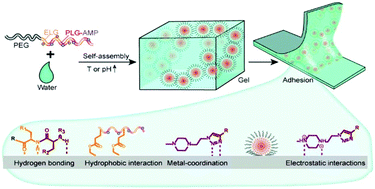Physiologically relevant pH- and temperature-responsive polypeptide hydrogels with adhesive properties†
Abstract
Physiologically relevant pH- and temperature-responsive polypeptide biomaterials have attracted increasing attention due to their versatile morphologies and functions responding to ambient changes. Herein, we prepare a series of polypeptide hydrogels via a ring-opening polymerization and post-modification strategy, which show tunable gelation temperature and pH, reversible sol–gel phase transition and adhesive properties. This approach is mainly based on the self-assembly of an amphiphilic polymer employing poly(ethylene glycol) and poly(L-glutamic acid) derivatives as temperature and pH responsive segments, respectively. We experimentally demonstrate that the temperature and pH responsiveness is a result of comprehensive effects of the variation of intermolecular interactions, electrostatic repulsion and secondary structures. The hydrogel is degradable and has good biocompatibility in vivo. Moreover, the hydrogel showed adhesive properties to a wide range of materials. This study provides a new class of stimuli-responsive hydrogels that respond to physiologically relevant pH and temperature and exhibit unique adhesive properties, as well as the underlying gelation mechanism.



 Please wait while we load your content...
Please wait while we load your content...